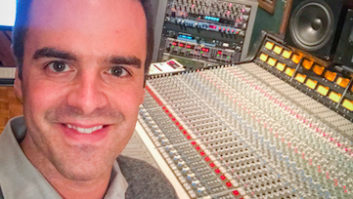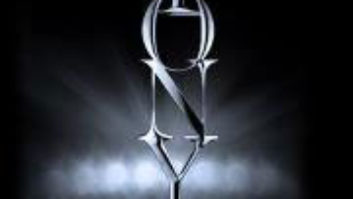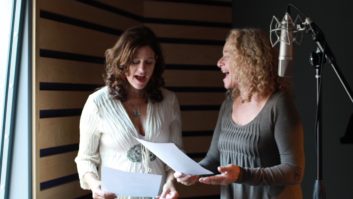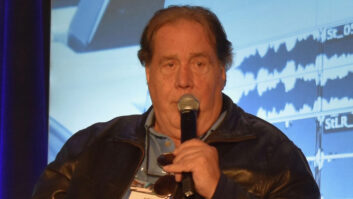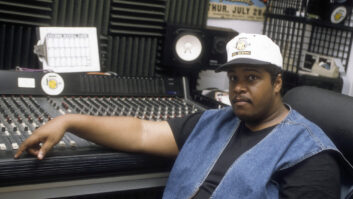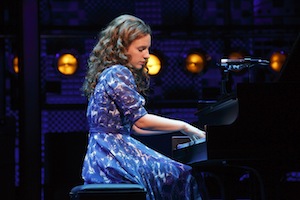
Jessie Mueller won a Tony for her portrayal of Carole King
Photo: Joan Marcus
Carole King burst onto the music world from nowhere in 1971 with her huge-selling album, Tapestry.
Well, yes and no.
Years before The Beatles disrupted the business, a teenaged Carole (Klein) King was a staff songwriter, penning pop and R&B hits in an office cubicle.
With songwriting-partner and husband Gerry Goffin, King wrote some of the biggest hits of the era—on salary and in a space big enough for an upright piano, bench, chair, two people and little else, at 1650 Broadway (“the famed rabbit warren where white people wrote songs for black singers,” quips Variety).
The unlikely path and duality of Carole King’s career—from teenage-Brooklyn-mom and Times Square-hitmaker to divorced-Laurel Canyon-zeitgeist-defining-megastar has made great copy since she swept the Grammys with the inescapable Tapestry.
Now her tale is Beautiful: The Carole King Musical, a Tony-winning Broadway smash-hit spanning 10-plus years of the artist’s life.
It starts in the late ’50s when a precocious teenager begs her mother to let her travel from Brooklyn to Times Square to pitch a song, and it concludes with the multi-platinum-selling artist’s triumphant gig at Carnegie Hall.
Beautiful also tracks the initially similar careers of songwriting team Cynthia Weill and Barry Mann (“You’ve Lost that Lovin’ Feelin’,” “Walking in the Rain,” “We Gotta Get Outta This Place”), who were Goffin/King’s cubicle colleagues and friendly competitors.
Beautiful won two 2014 Tony Awards; star Jessie Mueller [Carole King] won for best actress in a musical and sound designer Brian Ronan won for best sound design for a musical. The show was nominated for seven Tonys.
Sound design is indeed a big part of what makes Beautiful work, dramatizing the contrast between what the highly personal songs mean to their writers and how they’re transformed under the white hot light of show business.
Beautiful also uses the increasingly sophisticated changes in audio production styles—from the simple, tight 45 rpm-single sound of the late ’50s/early ’60s to the processed, expansive multitrack recording and richer live sound of the early ’70s—to help tell the story. As Carole King travels from Brooklyn to Times Square to a world stage, the increasingly richer audio quality tracks her journey. “The sound design follows Carole King dramaturgically, it is part of the storytelling, approximating the sounds that were available to her,” Ronan says.
When the scared-but-bold teenaged King auditions for music publisher Don Kirshner (who’d had a hit with her high school friend Neil Sedaka), sound designer Ronan begins to sonically emulate the time and place of the story.
“We begin with Carole playing an upright piano in Kirshner’s office,” Ronan explains. “It’s actually our conductor Jason Howland playing, as he watches Jessie Mueller via a hidden video camera, following her hands. Sonically, the effect is true to the script—an acoustic piano in an office.”
It sounds real because it is…sort of. The piano sound is indeed emanating from the onstage piano, from speakers hidden inside the prop instrument: Howland’s piano playing gets there via a wireless in-ear monitor rig. Any time an onstage piano, amplified guitar, TV, radio, etc., is playing, the sound is coming mainly from the onstage prop source via this technique, to focus the listener to the stage and enhance the verisimilitude.
Significant Broadway-style dramatic license is then taken as the rest of the band joins in, to support King’s description of how she hears her song sounding on a record.

2014 Tony-winning sound designer Brian Ronan at The Stephen Sondheim Theater, FOH, with the multi-level stage set that represents the 1650 Broadway offices where Carole King, Gerry Goffin, Cynthia Weil and Barry Mann wrote songs for publisher Don Kirshner, in the background.
Photo: Eric Rudolph
However, while the music swells, the amplification dials down. “We’re leaving sections of our band muted and allowing the acoustic instruments—mainly reeds and brass—to flow naturally from the pit to give an un-amplified, organic feel,” says associate sound designer Cody Spencer. “We’re keeping it simple, like she’s playing by herself, and the band is [coming from her imagination]. We’re showing how she thinks her music will sound, and also transitioning to bigger production numbers in the show.”
That scene is book-ended with a recorded track representing King’s first song sale and hit record, “It Might As Well Rain Until September.” This time the sound goes from big to small, evoking the way teen pop music sounded in the pre-Beatles era.
“An actor plays singer Bobby Vee while the pre-recorded music suggests a commercial pop song in 1962. We transition from the pre-record coming out of the whole P.A. and crossfade it down,” dramatically, from all those big speakers, “to a transistor radio carried by an actress playing a student,” says Ronan.
The effect is totally appropriate to the time; like hearing music through tiny cellphone speakers, tinny-sounding transistor radios were how teenagers heard Top 40 radio in mobile mode then. It is also quite convincing, as the sound actually comes from a tiny computer speaker in the prop radio the actress holds as she sashays across the entire stage, organically phasing the sound.
The transistor radio isn’t the only retro tech in Beautiful. Vintage mics abound onstage but are mostly props; the actors almost always use their hidden head mics. Actual working vintage mics were tried in a few scenes out of town, “but they sounded really, really bad,” notes Ronan wryly.
One powerful scene that called for a vintage mic approach instead got a completely anachronistic treatment due to audio and theatrical demands.
Near the end of Act I, when the staff-songwriting machinery nears full speed, Barry Mann (Jarrod Spector) gives the classic Mann/Weill hit “You’ve Lost that Lovin’ Feelin’” a quiet songwriter’s reading, intimate and full of youthful angst. Then actors portraying The Righteous Brothers come dramatically into the spots, singing the classic hit with the full band, approximating record producer Phil Spector’s legendary Wall of Sound, with major volume, reverb and compression. Their starkly contrasting performance is slick, sophisticated soul music.
The Righteous Brothers characters’ hip attitudes, slick hair, shiny skinny suits and vocals are all spot on, but audio purists may howl; the two singers are using modern Sennheiser wireless handheld mics. It is a big compromise for the sake of a dramatic, punchy vocal sound, contrasting with the preceding quieter solo vocal of the same song, and it was a reluctant compromise for Ronan.
“Out of town we started with prop vintage mics, but really using the singers’ head mics,” he says. “But you just can’t get the warmth and proximity effect that’s so familiar to everyone that way. The Sennheisers are, of course, not true to time, but we also needed no wires, to get on and off stage cleanly.”
Front of House
The Beautiful system runs 132 inputs, with 40 channels dedicated to head mics, mostly Sennheiser MKE-1s. The band gets 64 channels. The DiGiCo SD7T control surface, Spencer says, “really helps us; the tube emulator in each channel helps warm up and cut through, and the Dynamic Compression on every channel helps with some of the actors using side-rig head mics, instead of the preferred lav placement at the hairline. Side rigs makes it hard to get the chesty sound, so we’re easily able to warm them up.”
The Stephen Sondheim Theater, one of the newest on Broadway, also helps as it has only two levels and is fairly wide. “It is a great-sounding house,“ says Spencer. “Being new, it was built with some soundproofing and with acoustic paneling up top, and used a lot of porous material, not hard plaster.”
The main speakers are a center-hung line array of 12 L-Acoustics dV-DOSC and two Meyer Sound CQ-1s. The big CQ-1s “are aimed straight to front orchestra seats with just band, no vocals, to fill the front rows that don’t feel the band that much in those ‘money seats,’” Spencer notes.
Two L-Acoustics dV-SUBs are right and left just outside of the orchestra seating area and two more are up near the spot booth. More than 50 Meyer speakers do point source duty as well as foldback, with MM-4s and UPJuniors hidden onstage and in lighting towers as monitors. Foldback mix is band only, no vocals, with the actors feeling the house for their vocals. There are no in-ear monitors.
Meanwhile, even after The Beatles sideline salaried songwriters, the hits keep on coming for Goffin/King and Mann/Weill.
Later in Act II there is another dramatic audio transition where we initially hear a full-blown version of Goffin/King’s “Pleasant Valley Sunday,” a major hit for the original Prefab Four, The Monkees, mocking suburban life.

L-R: Jeb Brown as Don Kirshner, Jake Epstein as Gerry Goffin, Jessie Mueller as Carole King, Jarrod Spector as Barry Mann, and Anika Larsen as Cynthia Weil in Beautiful – The Carole King Musical.
Photo: Joan Marcus
The song is placed to dramatically put Goffin and King in their new suburban New Jersey home—a very big move for these lifelong city kids—as they audition this song for Kirshner. “The beauty of theater gives me license to start in full-tilt ’60s Hi-Fi sound,” with a wide left-right pan for the band and vocals, and kick and snare right up the middle, for a big, full sound true to the time. “It’s an unnatural, commercially-viable and chronologically-correct sonic image,” adds Ronan. This sound also reflects the new suburban affluence of King and Goffin.
As the lights come up the big, full production sound of the song crossfades to Goffin and King performing “Pleasant Valley Sunday” as songwriters in their suburban living room. “We begin to pan back the separation to a more natural centered sound and peel off the mics on the drums, until we’re just on piano,” Ronan explains.
“It’s one of my favorite moments because it marries the time, scene and sound in a way that allows the audience to take this mini journey,” from big show-business gloss to the simple home life of the writers, “unaware that the sound design has been manipulating them.”
Story-wise, all seems idyllic, with a second child for King and Goffin. Their creativity (and that of friends Barry Mann and Cynthia Weill) is flowing freely, and as writers they’re beginning to catch up with the changing times.
The 1960s sitcom-like interior of the suburban home is ironically the setting for a gritty Mann/Weill song, “We Gotta Get Out of this Place,” with the Mann character singing and strumming an electric guitar, all while seated with his striking blonde wife on a comfy sofa in the ‘burbs. As noted, the guitar sound comes mainly from the stage via a pit guitarist, thanks to a specially modified onstage Fender guitar amp.
All seems well until Kirshner explains that he loves “Pleasant Valley Sunday” and it will be perfect for his song-hungry new project: a weekly half-hour TV show that’s just like A Hard Day’s Night…just without the Beatles.
Goffin, who has long chafed at writing for teenagers and feels the pressure of The Beatles and Bob Dylan, explodes that he’s been reduced to writing songs for a sitcom. That foreshadows the final dissolution of the shaky marriage and King’s transformation into a solo megastar.
From here the sound grows fuller and richer, with more sophisticated use of reverb, compression and modern mixing techniques. The songs made so famous on
Tapestry take over, and King leaves the Jersey suburbs for Laurel Canyon in Los Angeles to write and record solo, after her marriage ends. She makes Tapestry and LP sales history, defines an era and inspires generations of female singer/songwriters.
As for the real Carole King, she stayed away from the Broadway version of her life for months.
“Ms. King wouldn’t come near the show. Couldn’t get her to do any press or promote it in any way. She’s kinda shy,” says Ronan. “She finally bought a ticket, disguised herself and watched the show.”
For the curtain call, Jessie Mueller sings “I Feel the Earth Move.” “Jessie uses a wireless handheld mic, so we can get good and loud over the clapping and singing along,” Ronan recalls of the night. “Carole King was brought onstage with our spare handheld mic and she just jammed with Jessie, no rehearsal, no soundcheck.”
The star did reach out to the sound designer, however. “She left me a lovely message on my phone when I got nominated for the Tony. I did get to meet her briefly on Tony night,” Ronan notes, concluding his Beautiful show business story.
